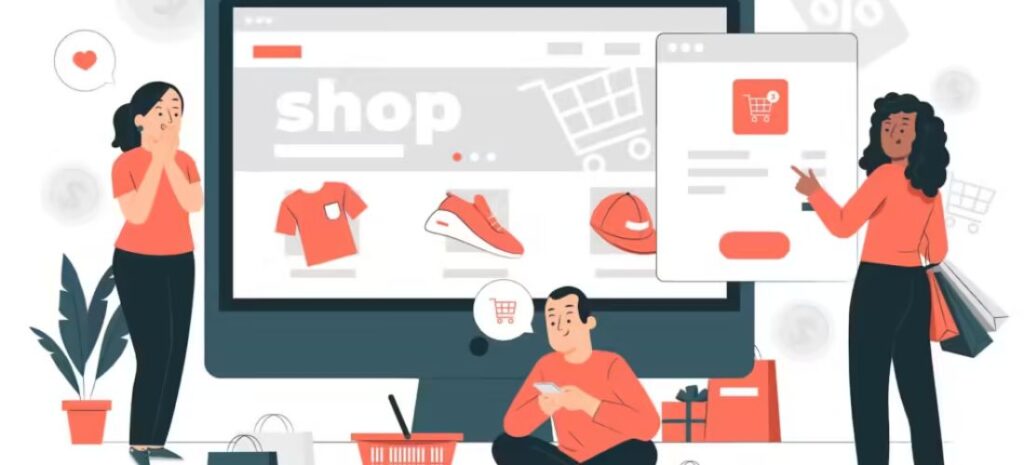“It’s not about how much time you have, it’s about what you do with the time you have.” – Nelson Mandela. We live in a society where every minute counts. Shopping can be frustrating for everyone from busy professionals to households if it takes up too much of your time. Either shopping is online or offline.
Today, with the rise of e-commerce, our shopping habits have changed a lot. Those days are gone when going to the mall for shopping was the only option. Today, online retailers offer convenience and easily available choices at our fingertips. But with all this digital convenience comes a new challenge: online shopping vs offline shopping? Which method is supreme? Offline and online shopping boasts unique pros and cons, catering to different preferences and needs.
Statistics of Online vs Offline Shopping in India
- E-retailing in India has been growing at a rate of 50-60% annually, with online retail accounting for 10% of e-commerce activities in the country.
- Approximately 80% of shoppers prefer online shopping due to convenience, especially regarding return policies that are often more favorable than those in physical stores.
- 2024, global e-commerce sales are expected to surpass $7 trillion, indicating a significant shift toward online shopping across various demographics.
- E-commerce accounted for over 19% of retail sales worldwide in 2023, projected to rise to 22% by 2027, reflecting a growing consumer inclination toward online platforms.
- The number of mobile shoppers is expected to reach 187 million in the U.S. by 2024, highlighting the increasing reliance on mobile devices for online shopping.
Also Read Gd Topic: Peer Pressure | Mob Lynching in India
Online shopping
Online shopping is like visiting a virtual store. You browse websites or apps, find the items you want, and pay using your phone, tab, or laptop. It is super easy and convenient – no traffic, no queues, shop anything anytime! Stores can be anywhere in India or even abroad. Compare prices, read reviews, and get your chosen item delivered straight to your home.
Also Read: Globalization | Climate Change
History of Online Shopping
1980s: The seeds of e-commerce were sown
The concept of online shopping has its roots in the 1980s. A visionary project called Radiophone Office Revolution, developed by Michael Aldrich, laid the foundation. This system allowed businesses to connect and conduct transactions electronically, laying the foundation for future online shopping experiences.
1994: The Web takes off
The arrival of the World Wide Web in the early 1990s opens the doors to online commerce. Secure online transaction systems emerged in 1994, including systems designed specifically for online shopping. Leading platforms such as NetMarket and Internet Shopping Network processed the first online shopping transactions, marking the beginning of the e-commerce boom.
1995: Rise of the retail giants
The year 1995 marked a turning point. E-commerce giants such as Amazon.com and eBay launched their websites, providing online shopping options to a wider audience. These companies remain major players in the online retail landscape today.
Also Read: Creativity vs Knowledge | Love vs Arrange Marriage

Also Read: Positive and Negative Impacts of Technology
Pros of Online Shopping
- Shop Anytime, Anywhere: Online stores are available 24/7, so you can browse and shop at your convenience, whether it’s a quick lunch break or a late-night impulse purchase.
- Avoid traffic and crowded routes. Shop from the comfort of your couch. Online shopping eliminates the hassle of physical stores.
- It’s very easy to research the best deal online. With a few clicks, compare prices and features between different vendors to ensure you get the most value for your money.
- Online reviews from other customers provide valuable information and help you make an informed decision before purchasing.
- Physical stores are limited by space. However, online retailers offer a wide range of products, including specialty items you may not be able to find locally.
- Online stores often offer promotions and discounts, allowing you to score amazing bargains on what you need and want.
Also Read: Reservation System in India | Government Job vs Private Jobs
Cons of Online shopping
Online shopping offers undeniable convenience, but it is important to consider some of the disadvantages before you “buy.” Here are some cons to keep in mind:
- Can’t Touch It Before You Buy It: You can’t touch it before you buy it, as you would in a physical store, online shopping does not allow you to inspect the product physically. You may receive an item that differs from the pictures or description, which can be disappointing
- Waiting for Your Purchase: Instant gratification is not always an option. Depending on the seller’s location and your chosen delivery method, you may have to wait several days or weeks to receive your purchase.
- Returns Can Be a Hassle: Returning defective items online can be a cumbersome process. You may need to print a return label, package the item securely, and wait for processing from the seller. This can be time-consuming and inconvenient.
- Security Concerns: Online scams and data breaches are a reality. Be cautious about unfamiliar websites and use secure payment methods to protect your financial information.
- Shipping Costs Can Add Up: While some online stores offer free shipping, others charge extra. Be mindful of shipping fees, especially for larger or heavier items, as they can significantly increase the overall cost.
Also Read: Work-Life Balance | Work From Home vs Work From Office
Offline Shopping
Offline shopping, the traditional method of buying goods, involves visiting physical stores. The excitement of browsing the shelves, trying on clothes, or getting advice from salespeople? That’s offline shopping! You go to a store, explore its selection, and make a purchase straight to the checkout counter. Although it may lack the flexibility of an online store, offline shopping offers the benefits of instant gratification and the ability to physically interact with products before purchasing.
Also Read: Traffic Rules In India | Child Labour in India

Pros of Offline Shopping
Offline shopping has its advantages that make it attractive to many people:
- You can get what you want instantly without waiting for delivery like online shopping.
- Hands-on Experience: You can touch and feel the products before buying, which is not available in online shopping.
- Returning items is quick and hassle-free, whereas online returns may take several days.
- Shopping in person with friends or family brings a feeling of satisfaction and joy.
- Personalized Suggestions: Staff can provide tailored suggestions based on your needs, saving you time on research.
- You can buy daily essentials like groceries and medicines instantly.
- You can pay by cash, card, QR code, or other methods, giving you more options.
- Cash transactions are more transparent and secure than online payments.
- You can try on clothes and shoes before purchasing to make sure they fit perfectly.
- People who are not tech-savvy or have limited access to the internet can easily shop offline without any problem.
Also Read: How to Fight Phone Addiction | Impact of Social Media on Youth
Cons of Offline Shopping
Although visiting physical stores is fun, there are some drawbacks to consider before going out. Here’s why offline shopping may not be better for some situations:
- Offline shopping requires traveling, energy, and waiting in line, which can be time-consuming compared to the quick browsing of online shopping.
- Local stores may not have everything you need. This caused you to visit multiple locations. Online stores offer huge catalogs, including exclusive items that you cannot find locally
- Bargaining can be stressful, and time-consuming. Offline prices might not be the best. Online stores allow for easy price comparisons across different sellers, helping you find the best deal.
- Temptation is everywhere! Due to strategic product placement and marketing tactics, physical stores can lead to unplanned purchases.
- Not everyone carries cash. Some stores may not offer online payment methods (credit cards, e-wallets, UPI), which may cause inconvenience.
- Heavy bags can be a burden. Online shopping offers the convenience of home delivery, eliminating the need to wander here and there to make your purchases.
- Not everyone likes to be chased by salespeople. Some stores may have overly attentive staff, which can make browsing inconvenient.
Also Read: Organic Farming — Good or Bad

Wrap-Up: Online Vs Offline Shopping – Which is Better?
Online shopping offers 24/7 convenience, easy comparison, and wide selection, but you cannot physically inspect the items and may have to wait for delivery. Offline shopping lets you see and touch products before you buy and get them immediately, but it requires travel and can be time-consuming. Both have pros and cons, so the best choice depends on your needs and preferences.
Also Read: Gender Equality | Women Empowerment
FAQs
Which one is better, online or offline shopping?
Online and offline shopping both have their advantages
Offline shopping lets you see and feel the products. This is important for items like clothes, electronics, or furniture. You can also get help from salespeople and enjoy the social aspect of shopping.
Online shopping offers convenience. You can browse and buy products from the comfort of your home, 24/7. It’s also easier to compare prices and find deals online.
The best choice depends on your needs and preferences. If you need something quickly and conveniently, online shopping might be the way to go. But if you want to see the product in person or get help from a salesperson, head to a physical store.
Also Read: Freedom: Real or Myth
What are the benefits of offline shopping?
Benefits of offline shopping
- See and feel products
- Get help from salespeople
- Immediate purchase and takeaway
- Social interaction
- Cash payment option
- Avoids delivery wait times
Also Read: Why are trees painted in India
What are the advantages or disadvantages of online shopping?
| Advantages | Disadvantages |
|---|---|
| Convenience (shop 24/7 from home) | Can’t see or feel products before buying |
| Wider selection of products | Return hassle if needed |
| Easier price comparison and deals | Delivery wait times |
| Faster checkout process (sometimes) | Shipping costs can add up |
| Security risks (online fraud) | No Security risks |
Also Read: Moonlighting in India | Cybercrime in India
What are the advantages or disadvantages of offline shopping?
| Advantages | Disadvantages |
|---|---|
| See and feel products before buying | Limited selection (depends on store) |
| Get help from salespeople | Can be crowded or have long lines |
| Immediate purchase and takeaway | Requires travel time and effort |
| Social interaction and shopping experience | May have higher overhead costs leading to potentially higher prices |
| Cash payment option | Less convenient compared to online shopping |
Also Read – Old Age Homes in India | Electric Vehicles in India
What is the risk of offline shopping?
While offline shopping offers many benefits, there are also a few potential risks to consider:
- Without the ability to easily compare prices or walk away to cool down, you might be more likely to buy things you don’t necessarily need at the moment.
- Unless you visit multiple stores, you might miss out on better deals available elsewhere.
- Return policies can vary between stores, and some may have stricter requirements than online retailers.
- Carrying cash can pose a risk of loss or theft if you’re not careful.
- Stores may not always have the specific item or size you’re looking for.
Also Read: Co-Education- Pros and Cons
Online vs Offline Shopping Questionnaire
- Do you like to shop online ?
- How Often do you shop Online?
- How much time do you spend on every visit?
- Which websites do you generally visit and like to use?
- Do look for deals or compare prices before you make your online purchase?
- What do you generally shop for?
- When you shop online, do you send URLs of the product to your close peers, for their opinion before making a purchase?
- Do you prefer shopping online from the website? Or using the Mobile App.
- Do you prefer Offline(in-store) shopping when compared to online shopping?
- When you go offline shopping, do you like to go along with friends or family who help you in making choices?
- Do you value the suggestions or help from the friendly salesman at exclusive stores?
- Does it interest you to know, what your friends/family are buying?
Also Read: Unemployment Rate in India





